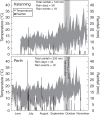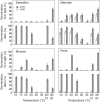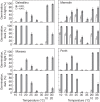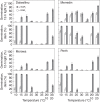Parental environment changes the dormancy state and karrikinolide response of Brassica tournefortii seeds
- PMID: 22492259
- PMCID: PMC3359922
- DOI: 10.1093/aob/mcs067
Parental environment changes the dormancy state and karrikinolide response of Brassica tournefortii seeds
Abstract
Background and aims: The smoke-derived chemical karrikinolide (KAR(1)) shows potential as a tool to synchronize the germination of seeds for weed management and restoration. To assess its feasibility we need to understand why seeds from different populations of a species exhibit distinct responses to KAR(1). Environmental conditions during seed development, known as the parental environment, influence seed dormancy so we predicted that parental environment would also drive the KAR(1)-responses of seeds. Specifically, we hypothesized that (a) a common environment will unify the KAR(1)-responses of different populations, (b) a single population grown under different environmental conditions will exhibit different KAR(1)-responses, and (c) drought stress, as a particular feature of the parental environment, will make seeds less dormant and more responsive to KAR(1).
Methods: Seeds of the weed Brassica tournefortii were collected from four locations in Western Australia and were sown in common gardens at two field sites, to test whether their KAR(1)-responses could be unified by a common environment. To test the effects of drought on KAR(1)-response, plants were grown in a glasshouse and subjected to water stress. For each trial, the germination responses of the next generation of seeds were assessed.
Key results: The KAR(1)-responses of seeds differed among populations, but this variation was reduced when seeds developed in a common environment. The KAR(1)-responses of each population changed when seeds developed in different environments. Different parental environments affected germination responses of the populations differently, showing that parental environment interacts with genetics to determine KAR(1)-responses. Seeds from droughted plants were 5 % more responsive to KAR(1) and 5 % less dormant than seeds from well-watered plants, but KAR(1)-responses and dormancy state were not intrinsically linked in all experiments.
Conclusions: The parental environment in which seeds develop is one of the key drivers of the KAR(1)-responses of seeds.
Figures







Similar articles
-
Seeds of Brassicaceae weeds have an inherent or inducible response to the germination stimulant karrikinolide.Ann Bot. 2011 Oct;108(5):933-44. doi: 10.1093/aob/mcr198. Epub 2011 Aug 5. Ann Bot. 2011. PMID: 21821831 Free PMC article.
-
Prior hydration of Brassica tournefortii seeds reduces the stimulatory effect of karrikinolide on germination and increases seed sensitivity to abscisic acid.Ann Bot. 2010 Jun;105(6):1063-70. doi: 10.1093/aob/mcq061. Epub 2010 Mar 25. Ann Bot. 2010. PMID: 20348089 Free PMC article.
-
Comparison of germination responses of Anigozanthos flavidus (Haemodoraceae), Gyrostemon racemiger and Gyrostemon ramulosus (Gyrostemonaceae) to smoke-water and the smoke-derived compounds karrikinolide (KAR1) and glyceronitrile.Ann Bot. 2013 Mar;111(3):489-97. doi: 10.1093/aob/mcs300. Epub 2013 Jan 8. Ann Bot. 2013. PMID: 23299994 Free PMC article.
-
Mechanisms of Maturation and Germination in Crop Seeds Exposed to Environmental Stresses with a Focus on Nutrients, Water Status, and Reactive Oxygen Species.Adv Exp Med Biol. 2018;1081:233-257. doi: 10.1007/978-981-13-1244-1_13. Adv Exp Med Biol. 2018. PMID: 30288713 Review.
-
Regulation of seed germination and seedling growth by chemical signals from burning vegetation.Annu Rev Plant Biol. 2012;63:107-30. doi: 10.1146/annurev-arplant-042811-105545. Epub 2012 Feb 9. Annu Rev Plant Biol. 2012. PMID: 22404467 Review.
Cited by
-
Effect of environmental factors on seed germination and seedling emergence of Viola prionantha, a cleistogamous plant.J Plant Res. 2023 Sep;136(5):631-641. doi: 10.1007/s10265-023-01461-9. Epub 2023 May 18. J Plant Res. 2023. PMID: 37202494
-
Phenotypic variation of life-history traits in native, invasive, and landrace populations of Brassica tournefortii.Ecol Evol. 2019 Nov 18;9(23):13127-13141. doi: 10.1002/ece3.5747. eCollection 2019 Dec. Ecol Evol. 2019. PMID: 31871634 Free PMC article.
-
Divergent receptor proteins confer responses to different karrikins in two ephemeral weeds.Nat Commun. 2020 Mar 9;11(1):1264. doi: 10.1038/s41467-020-14991-w. Nat Commun. 2020. PMID: 32152287 Free PMC article.
-
Species-specific effects of production practices on genetic diversity in plant reintroduction programs.Evol Appl. 2023 Nov 20;16(12):1956-1968. doi: 10.1111/eva.13614. eCollection 2023 Dec. Evol Appl. 2023. PMID: 38143906 Free PMC article.
-
Sustainable harvest: managing plasticity for resilient crops.Plant Biotechnol J. 2014 Jun;12(5):517-33. doi: 10.1111/pbi.12198. Plant Biotechnol J. 2014. PMID: 24891039 Free PMC article. Review.
References
-
- Adkins SW, Peters NCB. Smoke derived from burnt vegetation stimulates germination of arable weeds. Seed Science Research. 2001;11:213–222.
-
- Andrade A, Vigliocco A, Alemano S, Alvarez D, Abdala G. Differential accumulation of abscisic acid and its catabolites in drought-sensitive and drought-tolerant sunflower seeds. Seed Science Research. 2009;19:201–211.
-
- Arnold RLB, Fenner M, Edwards PJ. Changes in dormancy level in Sorghum halepense seeds induced by water stress during seed development. Functional Ecology. 1992;6:596–605.
-
- Australian Government Bureau of Meteorology. Climate Data Online. 2010 http://www.bom.gov.au/climate/data/ . 19 May 2010.
-
- Australian Government Bureau of Meteorology. Climate Data Online. 2011 http://www.bom.gov.au/climate/data/ . 30 June 2011.

